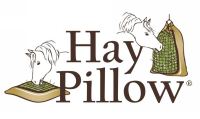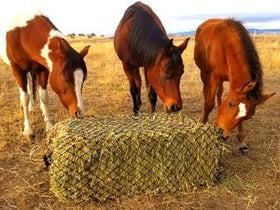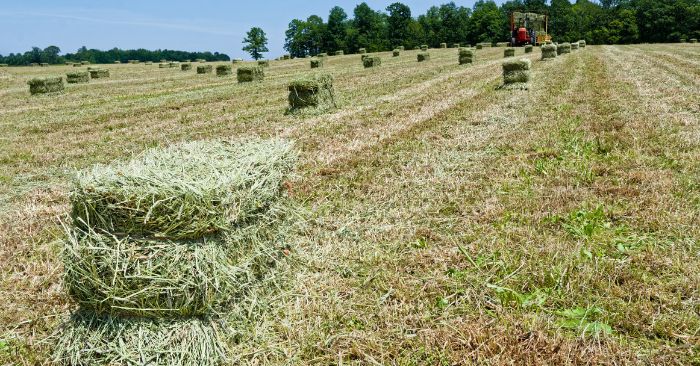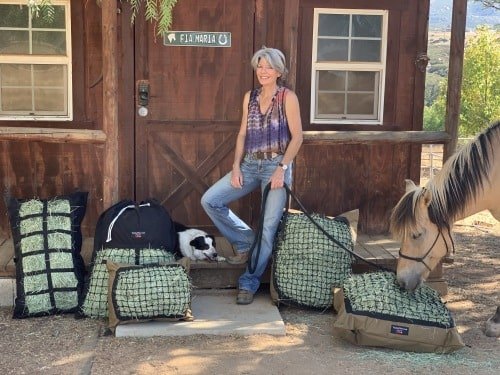Nitrates in Hay Exposed - What You Need to Know

I would buy enough hay to last a year. During the second year of this practice, my horses were not doing well. My mare was out of breath on a 20 minute hike; her allergies were the worst they had ever been. My gelding had old scars reappearing from years previous that the hair had fully regrown back in after healed.
When my vet came out for annual dental work and drew back the syringe to administer an IV sedative, his blood was dark and brownish. When searching for answers, it was suggested that I test my hay for nitrates. The results came back 4,700ppm and they had been ingesting the same hay for 7 months.
Nitrogen is one of the main chemical elements required for plant growth and reproduction second to water. When more soil nitrogen is present than needed for optimum growth, the plant can store what it does not utilize. Nitrate levels can increase to toxic levels in forages any time the nitrogen supply in the soil exceeds the nitrogen needs of the plant.
Nitrates can be present in high levels due to:
- Over fertilization or triggered by environmental stress such as drought, freeze or even cloudiness, where plant growth is restricted but absorption of nitrate from soil continues.
- Irrigation by water high in nitrates, run off from other water sources, certain herbicides and deficiencies of essential nutrients like phosphorus, sulfur and molybdenum can also contribute.
- Improperly cured or stored bales of hay with too much moisture - bacterial action can convert available nitrate to nitrite which is 7 to 10 times more toxic than nitrate.
Never assume that organic equates to low levels, over fertilization from any nitrogen source and poor field management can occur in any crop.
Nitrate is converted to nitrite in the large intestine of the horse. Nitrites in blood oxidize the iron atoms in hemoglobin from ferrous iron (2+) to ferric iron (3+), thus compromising the ability to supply oxygen to tissues in the body. Nitrite converts to ammonia, if there is more nitrite than can be converted it leads to hypoxia (deprivation of oxygen supply). The result is Acquired Methemoglobinemia - a blood disorder in which an abnormal amount of methemoglobin (a form of hemoglobin) is produced. Hemoglobin is the molecule in red blood cells that distributes oxygen to the tissues. Methemoglobin cannot release oxygen. It occurs after exposure to certain chemicals and drugs, including nitrates. In simpler terms, your horse’s tissues are being suffocated to some extent depending on exposure.
Clinical signs from sudden ingestion of highly toxic levels may include:
- Difficulty breathing
- Weakness
- Tremors
- Ataxia
- Rapid heartbeat
- Foaming at the mouth
- Grey/blue or brown discoloration of blood and tissues
- Seizures
- Rapid death
Abortion can occur in animals that survive the initial clinical signs. Chronic exposure to lower levels of nitrate has not been well researched in horses. Associations between chronic nitrate exposure and infertility, poor growth, hypothyroidism, frequent urination and other disorders have been claimed.
Minimizing nitrates in the diet is the most logical “cure” to these symptoms. We want our horses to thrive, not just survive. Knowing that nitrates deprive the tissues of oxygen affirms they are of no benefit.
“Safe” levels of nitrates are certainly debatable and published within a variety of ranges. For unadapted animals averaging 2,500ppm, slight risk (feed as 50% maximum of total forage for pregnant animals) with 2,500-5,000ppm, moderate risk (feed as no more than 50% of diet, not safe for pregnant animals). These levels are not necessary. In fairness to the growers, it would be impossible to produce crops at less than 1ppm on a consistent basis. I don’t think it unreasonable to require less than 1,000ppm to send any crop to market. The growers I purchase from are consistently less than 500ppm. The test results also indicate well balanced soil with ideal calcium; magnesium and phosphorus ratios.
Some plants are known accumulators of nitrates such as Fescue and Johnson grass, Barley, Flax, Sudan grass, Sorghum, Sugar beets, Soybean and Wheat. Non-accumulators include Bermuda, Rye, and Orchard grasses. None though are immune to high levels of nitrates.
Fields that are flood irrigated tend to be more risky in regards to pre-purchase tests. The lower lying areas in the field can be especially high in concentrations while the higher parts of the field are at acceptable limits. I tested 12 bales of hay from the top of a block of 82, the results were 800ppm prior to purchase, bought 60 bales from the same block and re-tested. It was 4,500ppm. The only way to know is by testing the actual hay you are buying, even if it the same field or stack.
Test results can be very confusing and difficult to decipher. For simplicity purposes use the % nitrate number. If results show % of nitrate at .30, multiply by 10,000 to convert to ppm.
30% Nitrate = .30 X 10,000 = 3,000ppm
I have tested my hay for 5 years and reviewed numerous results from other sources. Nitrate test results have been as high as 6,500ppm and less than 1ppm. Which one would you choose if you had the choice?
You as the consumer do have a choice. Ask your grower or feed store for a hay test including nitrates or test it yourself prior to purchase. The majority of horse owners take great pride in reading nutritional analysis labels of supplements and bagged feeds. Would you buy a bag of feed or supplement without a label? A nutritional analysis should accompany the hay you purchase for a multitude of reasons including but not limited to nitrates, sugars, starch and protein, major and trace minerals.
Helpful How-to Resources for Slow Feeding
- How & Where to Test Your Horse's Hay & Interpret Results
- Sand Colic - The Surprising (Simple) Cure & Prevention
- Are You a Prisoner of Feeding? Here's How I Broke Free
- How to Introduce & Incorporate Free-Choice Forage: A Detailed Action Plan
- Slow Feed Solutions for Any Environment
- 6 Great Reasons to Feed Your Horse from Ground Level
- 9 Benefits of Slow Feeding Horses
- 7 Slow Feed Dos and Dont's for Horses
- 7 Easy Ways to Help Prevent Colic
- Never Exercise Horses on an Empty Stomach...Ever
- Why You Shouldn't Transport Horses On An Empty Stomach
- Keeping Horses Warm Naturally – Internally and Externally
- Why Most Horse Prefer to Eat Outside
References
A.D.A.M. Medical Encyclopedia. Methemoglobinemia. http://www.ncbi.nlm.nih.gov/pubmedhealth/PMH0001588/






